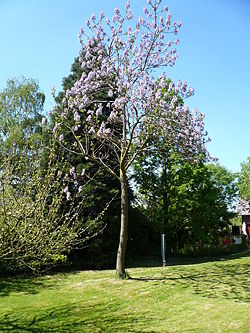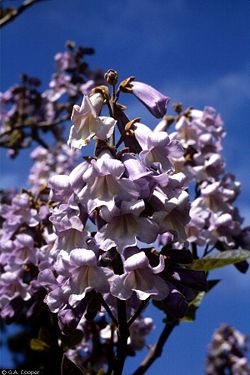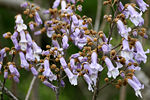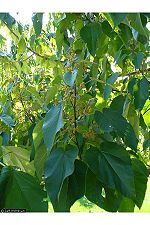Empress tree
| Empress tree |
|---|

|
| Scientific Classification |
|
| Binomial Name |
|
Paulownia tomentosa |
The Empress Tree or the Royal Princess Tree is a species of flowering plants known by the scientific name Paulownia tomentosa. It is perennial known for its ability to grow quickly. It comes from China but was then established in America introduced as an ornamental in 1840. This beautiful tree develops it's lavender flowers before it's leaves, so they stand out. They are known as a pioneer tree to some because of their ability to grown in bare soil. To some they are considered an invasive exotic.
Anatomy
The Empress tree is medium sized. They grow to be 60 feet tall, and the canopy can be 50 feet wide. The trunk can be 2 feet wide and the roots spread out wide. The branches are shallow and horizontal. The wood is soft, and easily broken. The bark is brown and rough. The leaves can grow to be 2 feet long are heart-shaped and velvety. The flowers are a tubular shape, lavender, about 2 inches long, and fragrant.
Reproduction
This tree grows very fast, and it begins to flower in 8 - 10 years. The flowers bloom in the spring, and show up before the leaves do, so they stand out beautifully. The flowers are insect pollinated. The fruit is a woody pointed type capsule with 4 compartments. They can contain up to 2,000 tiny seeds. The fruit is around 1 1/2 in. long. They are green, and turn brown in the fall, then they open up and release their seeds. and the seeds are dispersed by wind and water, and can be carried very far. The fruit, after releasing the seeds, stay on the tree through the winter. The tree can have up to 20 million seeds. The seeds are tiny and winged and they weigh 0.17 mg. The seeds germinate very quickly, all they need is sunlight and the right kind of soil. They usually like bare soil, and don't like to be shaded by other trees. The roots can also regenerate. The Trees usually don't live longer than 70 years because the taproot is not very strong, and so the tree isn't very structurally sound.
Ecology
The Empress tree is native to china, but was introduced to Europe in 1830, and then to America in 1840. It was introduced as an ornamental, since then it has become an invasive exotic, because of it's ability to grow quickly, and in hostile soil and disturbed natural areas. It can survive through fires, and being bulldozed because it can sprout from it's roots and stems.
Uses
The Empress Tree's Seeds used to be used as packing material in the 19 century. They were used for this because they were light and fluffy. Way back, in 300 BC it was already being used in china for medicine, timber, and as an ornamental. In China, they have a tradition where when a baby girl is born they plant an Empress tree. Then When she is about to be married, they will cut it down, and use the timber for her dowry. Today, in Japan, the wood is still highly valued for arts, because they use the soft wood to make carvings. Also a few Asian instruments are made from it, like the Japanese Koto and the Korean gayageum.
Gallery
 Browse |
References
- Palownia Tomentosa Wikipedia.
- Princess Tree Tom Remaley. PCA Alien Plant Working Group.
- Paulownia tomentosa John K. Kartesz. USDA.
- It's SuperTree! Paulownia.org.
- Empress Tree Davis Wiki.
- Paulownia Tomentosa Christina W. Longbrake. Global Invasive Species Database.
- Royal Paulownia F. T. Bonner. Paulownia tomentosa (Thunb.) Sieb. & Zucc. ex Steud.







